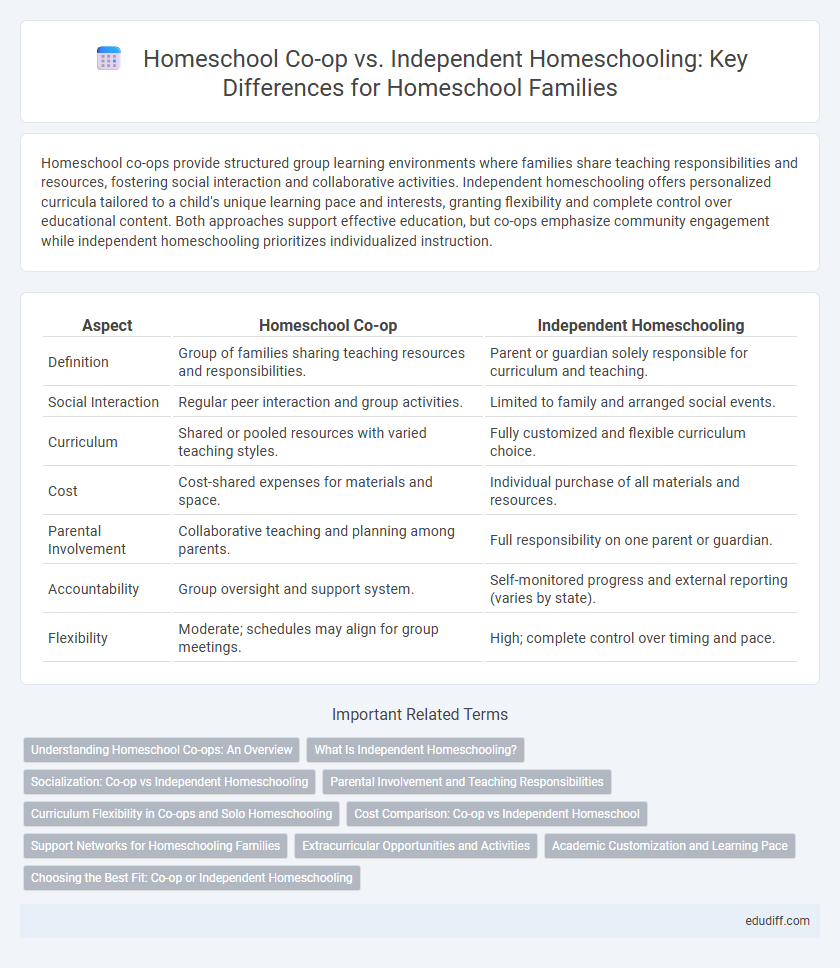Homeschool co-ops provide structured group learning environments where families share teaching responsibilities and resources, fostering social interaction and collaborative activities. Independent homeschooling offers personalized curricula tailored to a child's unique learning pace and interests, granting flexibility and complete control over educational content. Both approaches support effective education, but co-ops emphasize community engagement while independent homeschooling prioritizes individualized instruction.
Table of Comparison
| Aspect | Homeschool Co-op | Independent Homeschooling |
|---|---|---|
| Definition | Group of families sharing teaching resources and responsibilities. | Parent or guardian solely responsible for curriculum and teaching. |
| Social Interaction | Regular peer interaction and group activities. | Limited to family and arranged social events. |
| Curriculum | Shared or pooled resources with varied teaching styles. | Fully customized and flexible curriculum choice. |
| Cost | Cost-shared expenses for materials and space. | Individual purchase of all materials and resources. |
| Parental Involvement | Collaborative teaching and planning among parents. | Full responsibility on one parent or guardian. |
| Accountability | Group oversight and support system. | Self-monitored progress and external reporting (varies by state). |
| Flexibility | Moderate; schedules may align for group meetings. | High; complete control over timing and pace. |
Understanding Homeschool Co-ops: An Overview
Homeschool co-ops offer collaborative learning environments where families share teaching responsibilities, resources, and social activities, providing structured group classes and peer interaction. Independent homeschooling allows parents to customize curriculum and schedules individually, promoting flexibility but requiring sole responsibility for instruction and socialization. Understanding these models helps families choose between the community support of co-ops and the personalized freedom of independent homeschooling.
What Is Independent Homeschooling?
Independent homeschooling refers to a personalized education approach where parents design and implement their children's curriculum without relying on group settings or external organizations. This method allows for tailored learning experiences that adapt to a student's unique interests, learning pace, and family values. Unlike homeschool co-ops, independent homeschooling offers greater flexibility but requires more parental involvement and resource management.
Socialization: Co-op vs Independent Homeschooling
Homeschool co-ops offer structured socialization opportunities through group activities, cooperative learning, and regular peer interactions, enhancing children's social skills and teamwork. Independent homeschooling relies heavily on parents to create social experiences, which may lead to fewer consistent social engagements compared to co-ops. Research indicates co-op participants often demonstrate improved communication and collaboration abilities due to ongoing group dynamics.
Parental Involvement and Teaching Responsibilities
Parental involvement in homeschool co-ops often includes collaborative teaching responsibilities, where parents share expertise and facilitate group activities, enhancing social interaction and diverse learning experiences. Independent homeschooling requires parents to assume full responsibility for curriculum design, instruction, and assessment, demanding significant time management and subject proficiency. Both models prioritize active parental engagement but differ in the distribution of teaching duties and community support.
Curriculum Flexibility in Co-ops and Solo Homeschooling
Homeschool co-ops offer structured curriculum flexibility by providing shared resources and group instruction that accommodate diverse learning styles while maintaining a consistent schedule. Independent homeschooling allows for complete customization of curriculum pace and content tailored to individual student interests and needs, enabling parents to adjust lessons dynamically. Both approaches support varied educational goals, but co-ops emphasize collaborative learning environments, whereas solo homeschooling prioritizes personalized academic freedom.
Cost Comparison: Co-op vs Independent Homeschool
Homeschool co-ops often require membership fees or shared costs for group activities, which can range from $50 to several hundred dollars annually, while independent homeschooling primarily incurs expenses for curriculum materials, averaging $500 to $1,000 per year. Co-ops provide cost-sharing benefits for resources, field trips, and specialized instruction, potentially lowering individual expenses compared to independent homeschooling where all costs are borne by the family. Families choosing between co-op and independent homeschooling should consider potential savings on extracurricular activities against fees to determine the most budget-friendly option.
Support Networks for Homeschooling Families
Homeschool co-ops provide structured support networks where families share teaching responsibilities, resources, and social opportunities, enhancing children's learning experiences and easing parental workload. Independent homeschooling relies on self-directed support systems, often including local groups, online communities, and educational consultants to connect families seeking advice and encouragement. Both approaches offer unique social and academic benefits, with co-ops emphasizing collaboration and independent homeschooling prioritizing flexibility and personalized support.
Extracurricular Opportunities and Activities
Homeschool co-ops offer diverse extracurricular opportunities such as group sports, arts, and science clubs that foster social interaction and collaborative learning, which are often limited in independent homeschooling. Independent homeschoolers may rely on community programs or private lessons to access similar activities, requiring proactive coordination by parents. The structured environment of co-ops enhances access to varied hobbies and skill-building experiences, providing a richer social and educational extracurricular landscape.
Academic Customization and Learning Pace
Homeschool co-ops offer structured academic customization through collaborative lesson planning and shared resources, promoting a balanced learning environment. Independent homeschooling allows for complete control over curriculum choices and pacing, enabling personalized adjustments that match each student's unique learning speed and style. Both approaches support tailored education, but co-ops blend social interaction with customization, whereas independent homeschooling emphasizes individual flexibility.
Choosing the Best Fit: Co-op or Independent Homeschooling
Choosing between homeschool co-op and independent homeschooling depends heavily on family needs and learning goals. Homeschool co-ops provide structured socialization and shared resources, ideal for parents seeking community support and diverse group learning environments. Independent homeschooling offers customizable curriculum flexibility and personalized pacing, catering to families prioritizing tailored education and individual student interests.
homeschool co-op vs independent homeschooling Infographic

 edudiff.com
edudiff.com